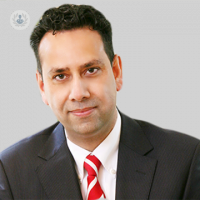Stem cells for back pain: is it effective?
Escrito por:The body can use stem cells whenever it needs them and they are naturally present in various parts of the body, such as the bone marrow, body fat tissue and in your blood vessels.
Stem cell therapy is an innovative science, known as ‘regenerative medicine’, where stem cells are extracted, manipulated in a laboratory and then implanted in the patient to regenerate and repair diseased or damaged tissues.
Here, orthopaedic spinal surgeon Mr Mo Akmal explains what happens during the procedure and if there is much evidence to support stem cells in cases of spinal cord injury or spinal degeneration.

What happens during the stem cell procedure?
Stem cells can be extracted under local anaesthetic with a needle from areas of the body with plenty of bone marrow, such as the pelvic bone or from body fat tissue by a procedure called lipoaspiration.
These cells can be sent to the laboratory for multiplication or storage or they are immediately concentrated and used for degenerative spine and joint treatments.
The procedure is usually performed as a day case at a specialist centre and is relatively painless. Some benefits are realised very quickly post-operatively. Stem cells can also be obtained from storage banks or cultured specifically for individual patients. This form of pure stem cell therapy is highly-regulated and only available at very few licensed centres in the world and is still considered experimental.
What is the current evidence base for stem cell therapy in spinal cord damage?
Stem cells injected into the spine have shown only limited success in being able to repair spinal cord damage to reverse paralysis and only in some animal studies have there been convincing results. However, there is immense work in this field and various regenerative techniques combining minor surgery and stem cell injections may offer better results in spinal cord injury treatment.
On the other hand, stem cell treatment of back pain from disc and facet joint degeneration has shown more promising results. Many studies in the past have shown that human disc cells cannot be grown and multiplied in the laboratory and also they can produce new disc tissue. By replenishing the absent spinal disc cells in the nucleus with stem cells that can develop into disc cells there is potential to improve spinal disc nutrient content and recover disc hydration.
This may lead to improved shock-absorbing capacity, strengthening of muscles and restoration of normal spine function. Stem cells also have the ability to directly reduce inflammation and recruit other natural healing factors to parts of the body that have wear and tear. There have been reports of significant relief of back pain in patients having these type of cells injected into their spines.
What research is needed?
A lot more clinical research needs to be done to identify the true benefits of stem cells and potential dangers such as uncontrolled growth of cells. The early results of stem cell treatment look very promising in the areas of joint and spinal disc preservation, if not regeneration, and it is likely that specialist clinics with the appropriately qualified doctors and proper approved facilities will be offering a variety of regenerative treatments in the near future to patients looking to avoid major surgery.



